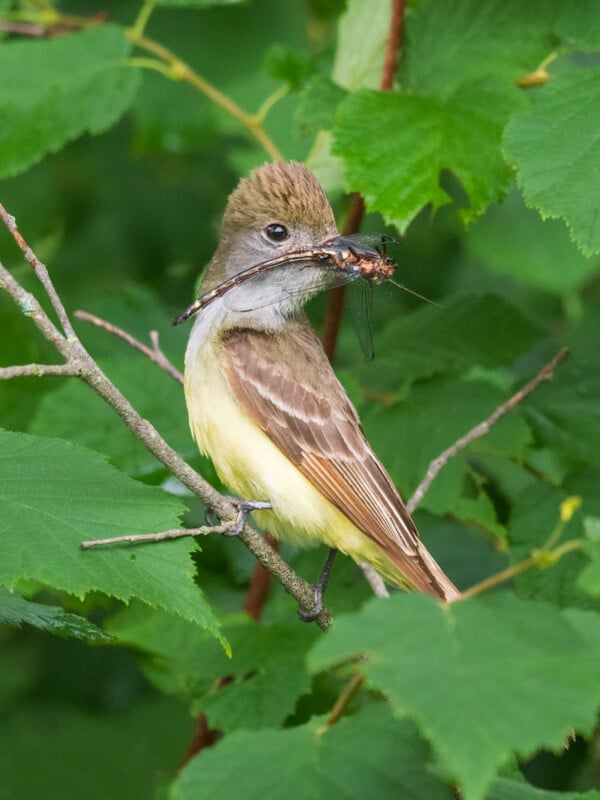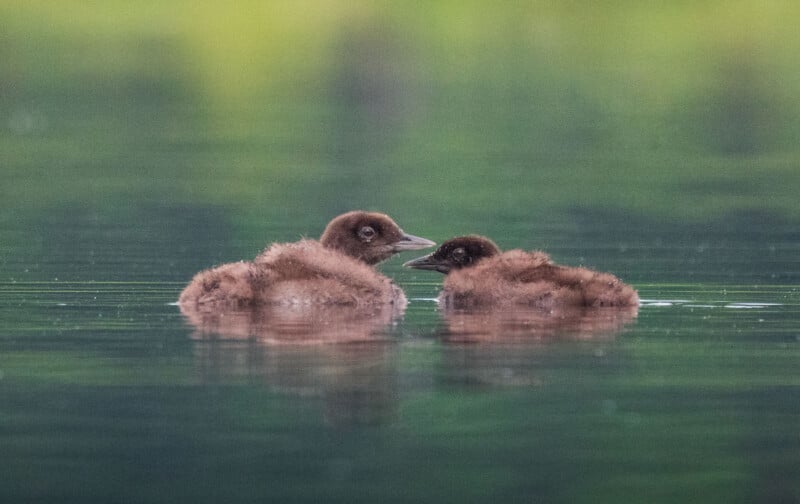
[ad_1]
![]()
It’s been a while since my last entry into the ongoing “Wildlife on a Maine Pond” series, but it’s not for lack of exciting wildlife activity. This entry will feature the debut of the animal I crossed my fingers for: baby loons.
About a month after building their nest and laying the typical clutch of two eggs, the breeding pair of loons that my dad and I have followed for years became parents. While this is far from the first time we’ve seen loon chicks, it never gets old seeing new life clumsily swim around, chirping for food, and napping on a parent’s back.
![]()
Photographing the baby loons is as challenging as it is rewarding, as the fluffy babies are tiny — little gray specks bobbing up and down in the water. When photographing loon chicks from a safe distance, as one always should, they are relatively small in the frame. As I’ve said numerous times in this series, the two-times crop factor of a Micro Four Thirds camera is super helpful for wildlife photography, especially when the subject is as small as a baby bird.

There’s also an emotional component to photographing baby loons. They’re adorable, and I love loons. But there’s the constant threat of peril. As soon as the chicks hatch, they’re swimming. They can’t dive and they can’t fly, so they are, almost literally, sitting ducks.
![]()
The dynamics of loon survival rates remain an area of intense focus. Still, generally, it’s practically a coin flip that a loon chick will survive into adolescence and be able to migrate in the fall. And with two loon chicks, the odds that they both make it is about one in four. I’ve seen it happen, but not often.
![]()
So each morning we put the kayaks in and head onto the water, there is a palpable anxiety about whether the loon chicks will still be there. And when photographing them, especially when their parents aren’t right next to them, a frequent occurrence, I dread a grizzled snapping turtle grabbing the baby from below or a bird of prey striking from above.

![]()
Baby loons, weighing little more than 140-150 grams (about five ounces) at birth, face a grim, harsh reality, and there’s nothing anyone can do about it. Turtles and eagles must eat, too, but I do always hope they find something, anything else for sustenance.
Last week, it appeared that both loon chicks had met a devastating fate. They were nowhere to be found.

I tried to be optimistic. There have been rare occasions over the years when we haven’t seen the loons on a particular day, as they have been tucked away in the weeds and didn’t come out in the morning. But that’s not the most likely explanation for a silent, empty pond.
![]()
However, fortunately, the unlikeliest proved the true one. The loons are still thriving and looking good.
They grow so fast. We photographed them in the first few days of their lives when the newly hatched chicks were covered in dark, downy feathers with white bellies.
Their eyes are still brown, a far cry from the brilliant red of their parents. The chicks have little dark feet, and stunted wings that look like someone threw them on at the last minute, like unfinished, wonky little clay sculptures of a bird rather than a living, breathing bird.

But make no mistake, these clumsy critters, while defenseless, don’t lack skills. As mentioned, they swim as soon as they are born. Forget learning how they’re born knowing. They also have other impressive instincts from day zero, like preening and drying their wings.
![]()
One of the siblings seemed more advanced than the other and was the first to take its first dives. Although they usually can’t dive until they’re at least a week old, which is impressive in its own right, one of the babies started plunking beneath the surface after just a few days.
![]()
After a few weeks, they begin to molt, sporting a fresh, lighter brown coat. They then get significantly bigger, can swallow larger fish, and even swim underwater for a while. This is about where the chicks are now, as they celebrate their one-month birthday this weekend, now much larger, longer, and browner.

They’re not out of the woods yet, but it’s hard to express the relief that washed over me when the baby loon’s strange absence was just an aberration.
Nature can be brutal and unforgiving. It is part of what makes the wild world so compelling, beautiful, and sometimes painful. But this year’s babies are still in the fight, and I’ve been fortunate enough to watch them grow, silently cheering them on from a distance.
![]()
Many nature and wildlife photographers can empathize with my emotions about the loon chicks. As passionate observers, we form an intense (but always respectful and hands-off) bond with wildlife. After you watch something take its first steps, paddle, or flight, it’s impossible not to care what happens to them. One day at a time, little loons.
Image credits: Photographs by Jeremy Gray and Bruce Gray
[ad_2]